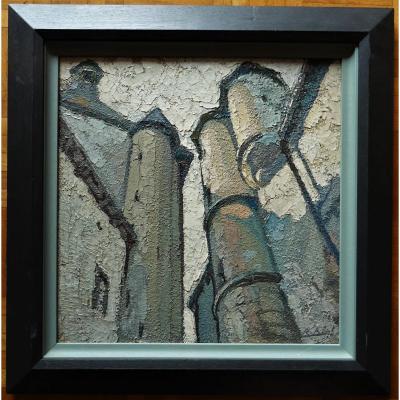"Robert Béat (1903-1990) "Entre ciel et tours Pays-basque, Périgord ? " Bretagne, Lille, Lambersat..Père de Robert Béat"
very original and beautiful oil / panel by Robert Béat dit rob béat (1903-1990) representing an urban view between sky and towers, perhaps in the Basque Country or in the North, signed lower right. format without frame 38x38cm. It is indeed a superb modern composition by rob béat representing once again a most original subject, as usual he chooses a very daring motif that he treats in an extremely modern way, with a touch that is very particular, a clever mix between Cubism and Fauvism and he uses a palette which is even more emblematic for him, which has even made his reputation, with in particular very personal grays, blues and greens. I only briefly present rob béat, a great painter from the north of France today renowned for his Basque and Breton scenes and portraits. There is an excellent website where you can find information on this family of painters, of which the blissful Father Paul was the precursor. (see www.kerkamak.com) Robert BEAT, painter: He was born on May 26, 1903 in Lambersart, a suburb of Lille, but it is in the rue Jordaens of this city that he will spend his life, in an astonishing house that 'with his father and his wife Mad they had transformed into a painter and decorator's paradise. Probably Robert Béat will draw before knowing how to write, among the Béat people are born with pencil in hand. In fragile health, he attended Fine Arts classes as regularly as possible, but in reality it was Paul Béat who was his real teacher. It must be said that the student has serious gifts and from the age of 18, in 1921, he made Lille Artists, with his father, his first exhibition. Obviously in his early works, the influence of the latter is obvious, but very quickly Robert Béat will free himself from it. This is explained by a totally different temperament. Robert is calm, infinitely sensitive, rather introverted and insensitive to honors and the public. In fact he paints more for himself than for others, the canvas and the brush being the means of expression of this naturally shy man. Besides, apart from the traditional family exhibition and the Artists from Lille each year, he will hardly ever exhibit outdoors except once or twice to the French Artists. At the beginning, therefore, he painted mostly landscapes in soft and pastel tones, but from the end of the 1920s his painting became firmer and more colorful, almost violent at times in the choice of colors which remained in spite of everything in a minor tone. At that time, if landscapes were still his favorite subjects, he began to make portraits and during the holidays in Brittany, in the Basque Country around 1935, he sketched genre scenes with characters taken from life. So, the key is thick, wide and the tones are brightened up while remaining very strong. Until after the war, it was necessary to notice his very particular technique, especially for the portraits which are made of touches of very contrasted colors, and whose opposition aims to give volume and a clear illumination delimiting the shadow and the light. From the frescoes he creates for decoration, he retains the construction technique incorporating for example, in a landscape, or in an animated scene, a face in the foreground. We will also constantly find in the organization of his paintings a concern for original "shots": prow of boats aligned like temple colonnades, view looking down on the quays with figures bent by the effort, street arcades in the foreground giving an impression of extreme depth of field, etc ... Astonishing portraits of Basques and Bretons (Pays Bigouden) from which a strength, a power emerges from the canvas, a little as if influenced by work of his wife Mad, he sought to truly sculpt the painting material. It is certain that the war of 1940 was an important break in the artistic career of Robert Béat because after this the activity of decoration having developed considerably he will have little time left to paint. So he went seven years without exhibiting. Fortunately in the meantime his son Jean-Paul arrived at the workshop and now they paint and exhibit three: ROB, MAD then MAB (Madeleine Agnès Béat) and JEAN-PAUL. Rob's painting (this is how he signs) has become less technical, and has naturally gained in liveliness and spontaneity. For example, the street scenes painted in Saint-Tropez, Villefranche, Spain, Portugal, the Black Forest and still in Brittany (Bigouden country and Quiberon peninsula) are softer than previously made with a single stroke of brush have a surprising veracity. In general and whatever the periods, Robert Béat was, like his father, always in search of the best technique to trap light and transpose it on the canvas. Funny detail, he had a holy horror, he said, of abstract painting, and yet towards the end of his life it is quite easy, in certain works ("Rue de Pampelune") to find a "non-figuration" obvious. Like what, Robert Béat was all his life an artist in perpetual evolution, knowing perfectly that behind the visible reality hides the intangible, the informal that only exceptional beings can reach. When we know the immense work of decorator that he executed and the importance of his pictorial production, we see that this apparently fragile man had in him an absolutely gigantic artistic creation force. this oil is in perfect condition, framed in a modern gilded frame guaranteed authentic



